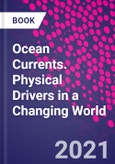Ocean Currents: Physical Drivers in a Changing World opens with a general introduction to the character, measurement, and simulation of ocean currents, leading to a physical and dynamical framework for understanding the wide variety of flows encountered in the oceans. The book comprises chapters covering distinct aspects of contrasting ocean currents: broad and slow, deep and shallow, narrow and swift, large scale and small scale, low latitudes and high latitudes, and moving in horizontal and vertical planes. Through this approach the authors cover a wide range of applications, from local to global, with considerable geographical context.
Please Note: This is an On Demand product, delivery may take up to 11 working days after payment has been received.
Table of Contents
1. Introduction to ocean currents basic principles of cause and effect, measurement and modelling tools, etc.2. Global gyres/Ekman drift slow background flows�and evolution/plastics/volcanic pumice/tsunami debris
3. Global western boundary currents�and life swift flows�and marine life; dispersal of turtle hatchlings
4. Global eastern boundary currents�and life European Slope Current; Californian, Humboldt and Benguela Currents; links to upwelling�and shifting ecosystems
5. Currents near the Equator�and fast trans-basin flows links to tropical climate variability (especially El Nino)
6. Connecting Oceans with upper ocean flows Agulhas and Tasman leakage (connecting Pacific, Indian and Atlantic Oceans)
7. Polar currents, icebergs�and sea ice the Antarctic Coastal Current and the Labrador Current (conveying icebergs); the East Greenland Current (and sea ice)
8. Connecting shallow (warm)�and deep (cold) currents with climate the Atlantic Meridional Overturning Circulation; the global Conveyor Belt circulation
9. Seasonal flows in shallow shelf seas (around the world)�and implications for pollution/biology
10. Indigenous (ancient) knowledge of ocean currents e.g., colonisation of Australia, Polynesia
11. Utility of ocean currents for seafarers in recorded history e.g., use of Gulf Stream for trans-Atlantic trade
12. Research Challenges�and the Future How might new technologies help us to develop a more complete understanding of ocean currents? How might currents change with climate, how might they change climate?








